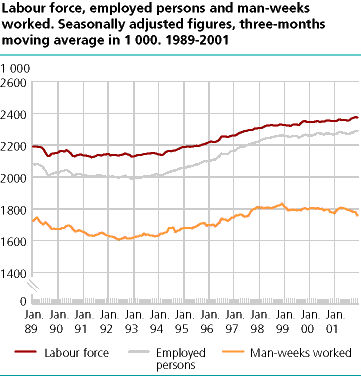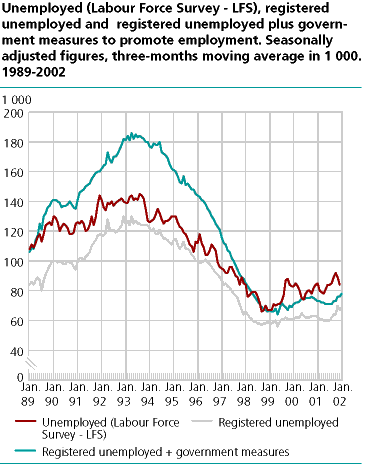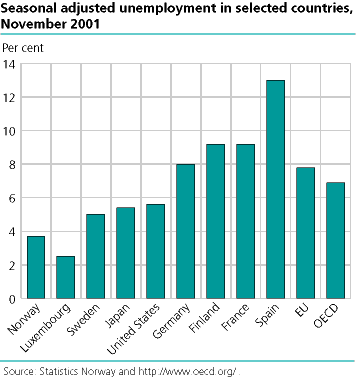Content
Published:
This is an archived release.
Still high labour force participation
Norwegian unemployment and employment have shown a weak increase during the last two years. As for earlier 3-months periods, the latest figures from the Labour Force Survey (LFS) only show changes that are within the error margins.
Seasonally adjusted figures indicate an increase in employment of 12 000 persons from the 3-months period August - October last year to November - January, while the unemployment decreased a little. The number of unemployed persons in the 3-months period November - January constitutes 3.6 per cent of the labour force, compared with 3.8 per cent in the previous 3-months period. The 0.2 percentage points decrease is within the error margins for the figures of change in the LFS caused by sample uncertainty. Seasonally adjusted figures of registered unemployed at the Employment Offices and persons on government measures to promote employment the last six months do not indicate an decrease in unemployment.
78 000 unemployed
A total of 2 275 000 persons were employed and 78 000 persons were unemployed in Norway in the fourth quarter of 2001 according to figures from the LFS not seasonally adjusted.
The number of man-weeks worked increased by 31 000 from the 3-months period August - October last year to November - January. The increase is probably within the error margins for these figures.
Unemployment in EU and OECD: 7.8 and 6.9 per cent
The OECD-area unemployment rate on a standardized basis was 6.9 per cent in November, 0.1 higher than in October and 0.6 percentage points higher than that a year earlier. In the European Union the unemployment rate remained stable at 7.8 per cent in November, 0,1 percentage points lower than a year earlier. The unemployment rate in the United States was 5.6 per cent in January this year, down by 0.2 percentage points since December last year, but up by 1,4 percentage points since January last year. In November last year the unemployment rate rose to 9.2 per cent in France. In Sweden the unemployment rate fell to 5.0 per cent. The unemployment rate remained stable at 9.2 per cent in Finland, at 8.0 per cent in Germany and at 5.4 per cent in Japan.
Uncertain man-weeks figures
Previous to the seasonal adjustment, we also make adjustments for holidays that fall in random months every year. Due to the fact that New Year's Day fell on weekday in January this year, we adjust the figure of man-weeks worked up by 55 000 prior to the seasonal adjustment. The adjustments are made so that the relative change in average weekly working hours from November to January this year is like last year's. The figure of man-weeks worked January last year were adjusted up by 51 000 fore the same reason. In January this year employed persons temporarily absent from work during the whole survey week were 12.3 per cent of all the employed persons, while 10.3 per cent were temporarily absent from work a year ago. It is difficult to say if this is caused by a change in the trend (due to longer total vacation), randomness, or a more seasonal variation. In January this year more persons than last year may have taken an extra week off, since the first reference week in January constitutes New Year's Eve and New Year's, which both fell on weekdays. January last year the first reference week had four regular a working days. Due to these two reasons the figures of man-weeks worked are especially uncertain this time.
The purpose of adjusting for seasonal variations is to describe the development during the last year and to give figures for change between the last two 3-months periods, cleared for normal seasonal variations. In order to reduce uncertainty, the presented series are three months moving averages of the seasonally adjusted figures. For instance the figure from December is the average of the estimates from, November, December and January.
Tables:
The statistics is published with Labour force survey.
Contact
-
Arbeidsmarked og lønn
E-mail: arbeidsmarked@ssb.no
-
Erik Herstad Horgen
E-mail: erik.horgen@ssb.no
tel.: (+47) 93 08 68 62



